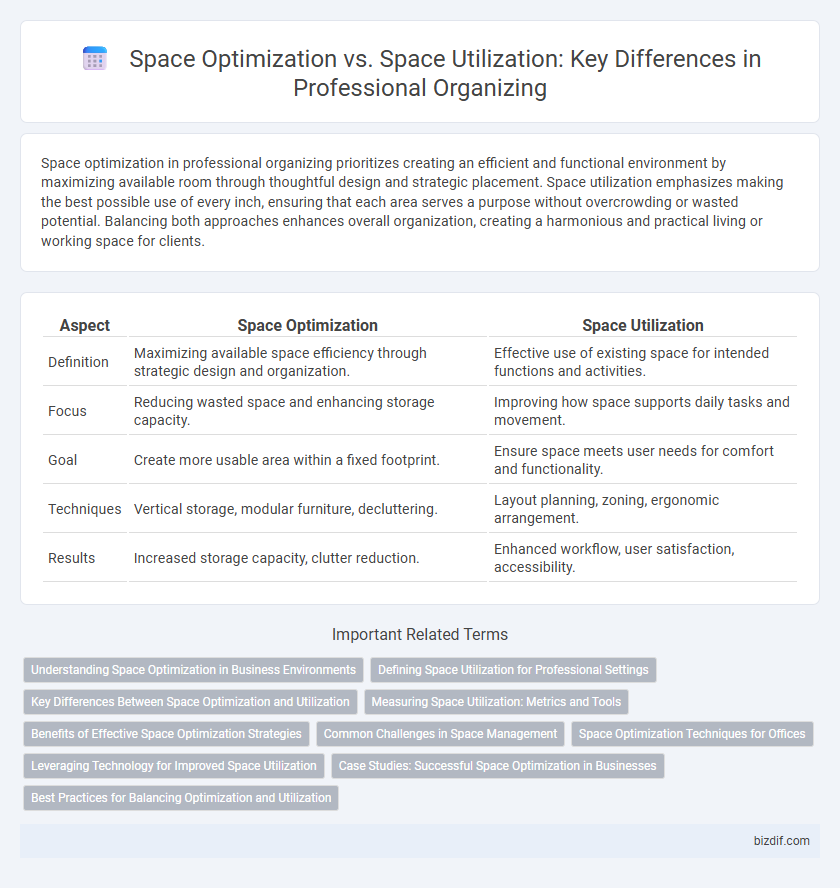Space optimization in professional organizing prioritizes creating an efficient and functional environment by maximizing available room through thoughtful design and strategic placement. Space utilization emphasizes making the best possible use of every inch, ensuring that each area serves a purpose without overcrowding or wasted potential. Balancing both approaches enhances overall organization, creating a harmonious and practical living or working space for clients.
Table of Comparison
| Aspect | Space Optimization | Space Utilization |
|---|---|---|
| Definition | Maximizing available space efficiency through strategic design and organization. | Effective use of existing space for intended functions and activities. |
| Focus | Reducing wasted space and enhancing storage capacity. | Improving how space supports daily tasks and movement. |
| Goal | Create more usable area within a fixed footprint. | Ensure space meets user needs for comfort and functionality. |
| Techniques | Vertical storage, modular furniture, decluttering. | Layout planning, zoning, ergonomic arrangement. |
| Results | Increased storage capacity, clutter reduction. | Enhanced workflow, user satisfaction, accessibility. |
Understanding Space Optimization in Business Environments
Space optimization in business environments focuses on strategically designing layouts to maximize functionality and efficiency, reducing wasted areas while enhancing workflow. This approach incorporates data-driven analysis and smart storage solutions to ensure every square foot contributes effectively to operational goals. Effective space utilization measures how the physical space is actively used, but space optimization goes further by aligning spatial design with business performance and employee productivity.
Defining Space Utilization for Professional Settings
Space utilization in professional settings refers to the efficient allocation and use of available physical areas to maximize functionality and productivity. It involves analyzing how workspace zones are occupied and ensuring every square foot supports workflow, employee comfort, and operational goals. Effective space utilization balances density with accessibility, reducing clutter while fostering collaboration and resource management.
Key Differences Between Space Optimization and Utilization
Space optimization focuses on strategically arranging and designing an area to maximize efficiency and functionality, often through customized storage solutions and layout adjustments. In contrast, space utilization measures how effectively the available space is used, emphasizing occupancy rates and activity distribution within a given environment. Key differences include optimization's goal of improving spatial effectiveness through design versus utilization's emphasis on tracking and assessing actual space usage patterns.
Measuring Space Utilization: Metrics and Tools
Measuring space utilization involves tracking key metrics such as occupancy rates, frequency of use, and dwell time to assess how effectively an area serves its intended purpose. Tools like occupancy sensors, space management software, and manual audits provide accurate data that inform decisions on optimizing layouts and resource allocation. These insights help professional organizers enhance functionality by balancing space optimization with actual utilization patterns.
Benefits of Effective Space Optimization Strategies
Effective space optimization strategies enhance both the functionality and aesthetic appeal of any environment by maximizing available square footage and reducing clutter. These strategies lead to improved workflow efficiency, increased storage capacity, and a more comfortable, organized living or working space. Optimized spaces contribute to better mental clarity and productivity by creating an environment tailored to specific user needs.
Common Challenges in Space Management
Space optimization targets maximizing the potential of available areas through strategic arrangement and design, while space utilization measures the actual use of that space over time. Common challenges in space management include ineffective layout planning, underutilized zones, and poor allocation of resources, which often lead to clutter and inefficiency. Addressing these issues requires data-driven analysis of traffic patterns, storage needs, and workflow to ensure that both space optimization and utilization goals are met.
Space Optimization Techniques for Offices
Space optimization techniques for offices prioritize maximizing functionality and efficiency by strategically arranging furniture, storage solutions, and workstations to enhance workflow and accessibility. Implementing modular furniture, vertical storage, and flexible layouts supports space optimization by adapting to changing needs while minimizing clutter. These techniques contrast with space utilization, which primarily measures how much area is occupied, focusing instead on how effectively office space serves organizational productivity.
Leveraging Technology for Improved Space Utilization
Leveraging technology enhances space utilization by integrating smart storage solutions, real-time space tracking, and AI-driven layout optimization, maximizing the efficiency of available areas. Advanced tools like 3D modeling software and IoT sensors enable precise space measurement and adaptive reconfiguration, minimizing wasted space and improving functionality. This technological approach transforms traditional space optimization into dynamic space utilization, aligning with professional organizing principles to create more organized, accessible, and productive environments.
Case Studies: Successful Space Optimization in Businesses
Case studies in professional organizing reveal that space optimization enhances business efficiency by strategically arranging physical assets to maximize functional areas, unlike mere space utilization, which focuses on filling available space. Companies implementing space optimization reported up to 30% increased workflow efficiency and a 25% reduction in clutter-related downtime. Examples include retail stores maximizing display areas and offices redesigning layouts to foster collaboration and reduce unused zones.
Best Practices for Balancing Optimization and Utilization
Space optimization maximizes the efficiency of available areas by reducing clutter and prioritizing essential items, while space utilization focuses on effectively using every square foot for functionality and accessibility. Best practices for balancing these include implementing modular storage solutions, regularly assessing usage patterns, and customizing organization systems to adapt to changing needs. Combining optimization with utilization ensures a harmonious environment that supports productivity without sacrificing comfort.
Space optimization vs Space utilization Infographic

 bizdif.com
bizdif.com